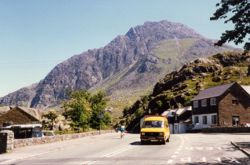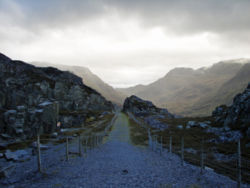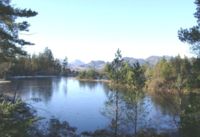Snowdonia
2007 Schools Wikipedia Selection. Related subjects: Geography of Great Britain
Snowdonia ( Welsh: Eryri) is a region of north Wales and a National Park, of 838 square miles (2170 square kilometres) in area. It was the first to be designated of the three National Parks in Wales, in 1951.
Name and extent
The English name for the area derives from Snowdon, which is the highest mountain in Wales at 1085 metres (3560 feet). In Welsh, the area is named Eryri. It is a common assumption that this is derived from eryr ("eagle"), but in fact it means quite simply Highlands, as leading Welsh scholar Sir Ifor Williams proved.
Today the word "Snowdonia" is largely synonymous with the Snowdonia National Park, although prior to the designation of the boundaries of the National Park, the term "Snowdonia" was generally used to refer to a smaller area, namely the more mountainous and northern areas closer to Snowdon itself. This is apparent in books published prior to 1951 such as "Wild Wales" by George Borrow (published by Collins, London in 1862) and "The Mountains of Snowdonia" by H.Carr & G.Lister (published by Lockwood, London in 1925). F.J. North, as editor of the book "Snowdonia" (published by Collins, London in 1949) states "When the Committee delineated provisional boundaries, they included areas some distance beyond Snowdonia proper."
Snowdonia National Park
Snowdonia National Park ( Welsh: Parc Cenedlaethol Eryri) was established in 1951 as the third national park in England and Wales. It covers 2,142 km² (840 square miles), and has a 60km coastline.
The Park is governed by the Snowdonia National Park Authority, which is made up of local government and Welsh national representatives. Unlike national parks in other countries, Snowdonia (and other such parks in England and Wales) are made up of both public and private lands under central planning authority. The makeup of land ownership at Snowdonia is as follows:
| ownership type | share (%) |
|---|---|
| Private | 69.9 |
| Forestry Commission | 15.8 |
| National Trust | 8.9 |
| CCW | 1.7 |
| National Park Authority | 1.2 |
| Water Companies | 0.9 |
| Other | 1.6 |
More than 26,000 people live within the Park, of whom about 62% speak Welsh . The Park attracts over 6 million visitors annually, split fairly equally between day vistors and paying visitors , making it the third most visited national park in England and Wales. Whilst most of the land is either open or mountainous land, there is a significant amount of agricultural activity within the Park.
Since the local government re-organisation of 1998, the Park lies partly in the County of Gwynedd, and partly in the County Borough of Conwy. It is governed by the 18 member Snowdonia National Park Authority, 9 of whose members are appointed by Gwynedd, 3 by Conwy, and the remaining 6 by the National Assembly for Wales.
Unusually, Snowdonia National Park has a hole in the middle, around the town of Blaenau Ffestiniog, a slate quarrying centre. This was deliberately excluded from the park when it was set up in order to allow the development of new light industry to replace the decimated slate industry.
Mountain ranges in Snowdonia
Snowdonia may be divided into four areas. The northernmost area is the most popular with tourists, and includes (west to east): Moel Hebog, Mynydd Mawr and the Nantlle Ridge; the Snowdon massif; the Glyderau, and the Carneddau. These last three groups are the highest mountains in Wales, and include all Wales' 3000-foot mountains.
The second area includes peaks such as Moel Siabod, Cnicht the Moelwyn, and the mountains around Blaenau Ffestiniog (a slate-quarrying town excluded from the National Park in order to facilitate the development of light industry there).
The third area includes the Rhinogydd in the west as well as the Arenig and the Migneint (this last being an area of bog, not a mountain). This area is not so popular with tourists, due to its remoteness.
The southernmost area includes Cadair Idris, the Tarren range, and the Aran group, including Aran Fawddwy, the highest mountain in the United Kingdom south of Snowdon.
Mountain walking in Snowdonia
Many of the hikers in the area concentrate on Snowdon itself. It is widely regarded as a fine mountain, but it can become quite crowded, particularly with the tourist railway running to the summit. Some hikers find some of the other high mountains slightly disappointing, with their flat boulder-strewn summits. However, there are some spectacular walks in Snowdonia on the lower mountains, and they tend to be relatively unfrequented.
Among hikers' favourites are Y Garn (east of Llanberis) along the ridge to Elidir Fawr; Mynydd Tal-y-Mignedd (west of Snowdon) along the Nantlle Ridge to Mynydd Drws-y-Coed; Moelwyn Mawr (west of Blaenau Ffestiniog); and Pen Llithrig y Wrach north of Capel Curig. Further south are Y Llethr in the Rhinogydd, and Cadair Idris near Dolgellau.
The Park has 2,381km of public footpaths, 264km of public bridleways, and 74km of other Public Rights of Way. A large part of the Park is also covered by Right to Roam laws.
Nature, landscape and the environment
The Park's entire coastline is a Special Area of Conservation, which runs from the Llyn Peninsula down the Mid Wales coast, the latter containing valuable sand dune systems.
The Park's natural forests are of the mixed deciduous type, the commonest tree being the oak. Birch, ash, mountain-ash and hazel are also common. The Park also contains some large (planted) coniferousforested areas such as Gwydir Forest near Betws-y-coed, although some areas, once harvested, are now increasingly being allowed to regrow naturally.
Northern Snowdonia is the only place in Britain where the Snowdon Lily, an arctic alpine plant, and the rainbow-coloured Snowdon Beetle are found.
A large proportion of the Park is today under designation (or under consideration for designation) as Sites of Scientific Interest, National Nature Reserves, Special Areas of Conservation, Special Protection Areas, Biosphere and Ramsar sites.
One of the major problems facing the Park in recent years has been the growth of Rhododendron ponticum. This fast growing alien species has a tendency to take over and stifle native species from growing. It can form massive towering growths and has a companion fungus that grows on its roots producing toxins that are poisonous to any local flora and fauna for a 7 year period after the Rhododendron infestations have been eradicated. As a result there are a number of desolate landscapes.



